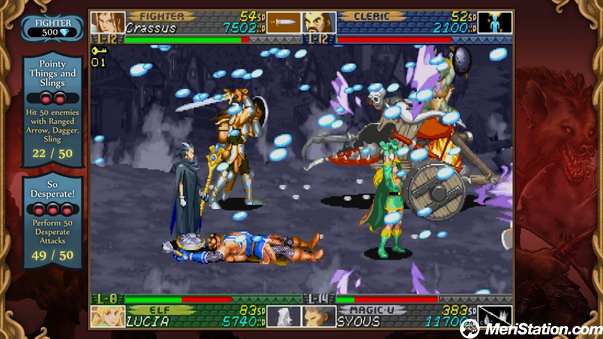The beat ’em up is a genre once branched from the games of fights of lateral advance, which gave depth to give the player the ability to move to the bottom and outside the stage. Renegade (Technos, 1986) is considered as the first representative of the playful d
iscipline that came to be known as “me against the neighborhood”, due to the street and street themes of many of his titles. Double Dragon (Technos, 1987) raised the bar for quality and popularity of the newborn discipline, but it would be two years later, back in 1989,
when the beat ’em up would become one of the most popular genres of arcade shows thanks to three extraordinary titles: Teenage Mutant Ninja Turtles, by Konami; Golden Ax, by Sega; and, above all, the immortal Final Fight, by Capcom.
And, although the games of fight versus were given to the spectacular, the competitiveness and the immediacy of a rush of adrenaline without equal, were also legion players who continued to support the beat ’em up above everything else.
The reasons are many, among which stand out the social game (the beat ’em up that allowed simultaneous participation for a total of four players were more than numerous) and the economy itself, since this was one of the genres where more could reach to surrender a coin of 25 pesetas to little that dominated the game in question. Thus, Capcom continued to launch
titles that did nothing but improve and improve the already extraordinary quality of Final Fight. We talk about authentic playful wonders like The King of Dragons (1991), Captain Commando (1991), Knights of the Round (1991),
Dungeons & amp; Dragons: Tower of Doom stood out among the rest of the beat ’em ups of the time even though the level was quite high. His second installment, Shadow Over Mystara, has already broken all records.
But here Capcom premiered at the end of 1993 its new, brand new and powerful recreation board called Capcom Play System II (CPS-2 for friends). He did it with two titles: Super Street Fighter II, the first major major update of his overwhelming fighting game, and
Eco Fighters, a side scrolling matamarcianos. Of course, it would not be long until a beat ’em up joined this new generation arcade; and often beat ’em up, gentlemen. Mention as a curiosity that among the developers of Dungeons & Dragons: Tower of Doom,
a game that would end up being hailed as an eternal cult classic, was George Kamitani, who years later would swell the ranks of Vanillaware, masters of the two dimensions that in a few weeks they will give us Dragon’s Crown, considered spiritual heir of these D & D.
Without losing at any time its roots of “me against the neighborhood” (yes, fantastic atmosphere instead of street), Tower of Doom added a series of features taken from the RPG license on which the game was based, which they sat him like a glove, they eliminated
with a stroke of the pen the main deficiencies that had dragged the beat ’em up until then (mainly the monotony in the development and the constant repetition of enemies), and above all they resulted in a surprisingly long game to be a recreational game, endowed
with a duration more typical of a console game of the time than an arcade title designed for coins to flow constantly into the interior of the piece of furniture.
Four characters to choose from with a range of attacks and unprecedented possibilities in the genre, multitude of levels and routes to take, countless items to collect, outstanding technical section that thoroughly squeezed the potential of CPS-2 …
Managing such characteristics, the success of the game was inevitable. From the year of its launch, 1994, rare was the recreational room that did not have a piece of furniture that hoarded inside a Tower of Doom plate.
The% 22horrible black dragon% 22, first really serious obstacle that we must face in Tower of Doom.
A couple of years later, Capcom surpassed the unsurpassable by launching a second part that, with the title of Dungeons & Dragons: Shadow Over Mystara, gave everything that should be required to a sequel and can be summarized in three words: more and better.
With two new characters, a wider range of attacks for the four warriors coming from Tower of Doom, even more weapons and items, and a length that touched the incredible (spending entire hours playing with a single coin was something that few recreational could boasting),
Shadow Over Mystara became the best beat ’em up of the classic cut ever launched on its own merits, an award that still remains today and that only the next Dragon’s Crown can aspire to snatch. Unfortunately


